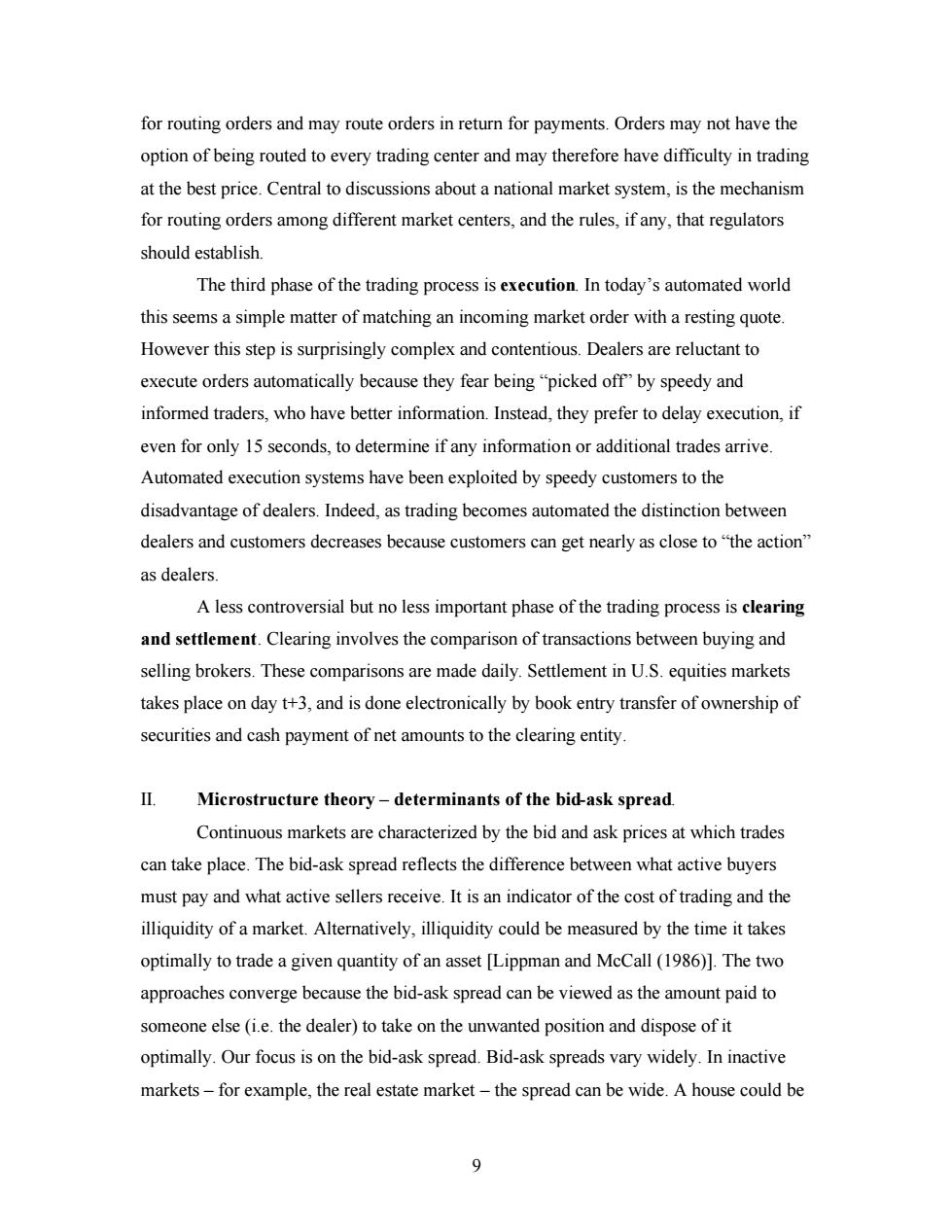正在加载图片...

for routing orders and may route orders in return for payments.Orders may not have the option of being routed to every trading center and may therefore have difficulty in trading at the best price.Central to discussions about a national market system,is the mechanism for routing orders among different market centers,and the rules,if any,that regulators should establish The third phase of the trading process is execution.In today's automated world this seems a simple matter of matching an incoming market order with a resting quote. However this step is surprisingly complex and contentious.Dealers are reluctant to execute orders automatically because they fear being"picked off by speedy and informed traders,who have better information.Instead,they prefer to delay execution,if even for only 15 seconds,to determine if any information or additional trades arrive. Automated execution systems have been exploited by speedy customers to the disadvantage of dealers.Indeed,as trading becomes automated the distinction between dealers and customers decreases because customers can get nearly as close to"the action" as dealers A less controversial but no less important phase of the trading process is clearing and settlement.Clearing involves the comparison of transactions between buying and selling brokers.These comparisons are made daily.Settlement in U.S.equities markets takes place on day t+3,and is done electronically by book entry transfer of ownership of securities and cash payment of net amounts to the clearing entity. Ⅱ. Microstructure theory-determinants of the bid-ask spread Continuous markets are characterized by the bid and ask prices at which trades can take place.The bid-ask spread reflects the difference between what active buyers must pay and what active sellers receive.It is an indicator of the cost of trading and the illiquidity of a market.Alternatively,illiquidity could be measured by the time it takes optimally to trade a given quantity of an asset [Lippman and McCall(1986)].The two approaches converge because the bid-ask spread can be viewed as the amount paid to someone else (i.e.the dealer)to take on the unwanted position and dispose of it optimally.Our focus is on the bid-ask spread.Bid-ask spreads vary widely.In inactive markets-for example,the real estate market-the spread can be wide.A house could be 99 for routing orders and may route orders in return for payments. Orders may not have the option of being routed to every trading center and may therefore have difficulty in trading at the best price. Central to discussions about a national market system, is the mechanism for routing orders among different market centers, and the rules, if any, that regulators should establish. The third phase of the trading process is execution. In today’s automated world this seems a simple matter of matching an incoming market order with a resting quote. However this step is surprisingly complex and contentious. Dealers are reluctant to execute orders automatically because they fear being “picked off” by speedy and informed traders, who have better information. Instead, they prefer to delay execution, if even for only 15 seconds, to determine if any information or additional trades arrive. Automated execution systems have been exploited by speedy customers to the disadvantage of dealers. Indeed, as trading becomes automated the distinction between dealers and customers decreases because customers can get nearly as close to “the action” as dealers. A less controversial but no less important phase of the trading process is clearing and settlement. Clearing involves the comparison of transactions between buying and selling brokers. These comparisons are made daily. Settlement in U.S. equities markets takes place on day t+3, and is done electronically by book entry transfer of ownership of securities and cash payment of net amounts to the clearing entity. II. Microstructure theory – determinants of the bid-ask spread. Continuous markets are characterized by the bid and ask prices at which trades can take place. The bid-ask spread reflects the difference between what active buyers must pay and what active sellers receive. It is an indicator of the cost of trading and the illiquidity of a market. Alternatively, illiquidity could be measured by the time it takes optimally to trade a given quantity of an asset [Lippman and McCall (1986)]. The two approaches converge because the bid-ask spread can be viewed as the amount paid to someone else (i.e. the dealer) to take on the unwanted position and dispose of it optimally. Our focus is on the bid-ask spread. Bid-ask spreads vary widely. In inactive markets – for example, the real estate market – the spread can be wide. A house could be